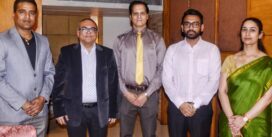- फेलिसिटी थिएटर इंदौर में "हमारे राम" प्रस्तुत करता है
- जेएसडब्ल्यू ग्रुप के चेयरमैन सज्जन जिंदल को एआईएमए मैनेजिंग इंडिया अवार्ड्स में मिला 'बिजनेस लीडर ऑफ डिकेड' का पुरस्कार
- उर्वशी रौतेला 12.25 करोड़ रुपये में रोल्स-रॉयस कलिनन ब्लैक बैज खरीदने वाली पहली आउटसाइडर इंडियन एक्ट्रेस बन गई हैं।
- Urvashi Rautela becomes the first-ever outsider Indian actress to buy Rolls-Royce Cullinan Black Badge worth 12.25 crores!
- 'मेरे हसबैंड की बीवी' सिनेमाघरों में आ चुकी है, लोगों को पसंद आ रहा है ये लव सर्कल
Apollo expert details India-specific scenario related to sickle cell disease

New Delhi : Indraprastha Apollo Hospitals organised a health awareness program to mark the occasion of World Sickle cell day which is observed every year on June 19.
Eminent expert on blood disorders, Dr Gaurav Kharya, Clinical Lead, Centre for Bone Marrow Transplant and Cellular Therapy, Senior Consultant – Paediatric Haematology – Oncology & Immunology highlighted that India has the second highest burden of the disease and it is most prevalent in South India, Chhattisgarh, Bihar, Maharashtra and neighboring areas of Madhya Pradesh.
Doctor also spoke about its symptoms and how to go about caring for the patients stricken with the disease.
Dr Gaurav Kharya expounded upon the ailment, “Sickle cell disease is an inherited blood disorder which is characterized by defective haemoglobin (HbS), with a typical S shape. Normal haemoglobin (HbA) is ‘O’ shaped. Haemoglobin is supposed to carry oxygen to different parts of the body. However due its defective shape, the red blood cells (RBCs) cluster together and are unable to move through the blood vessels easily.
These clusters obstruct the small arteries and capillaries, thus stopping the movement of oxygenated blood which causes many complications. In comparison to normal RBCs which live for about 120 days, these defective cells live for 10-20 days maximum.
Due to this, the number of haemoglobin cells in the body lessens significantly causing chronic anemia. Patients suffering from this tire easily, due to lack of enough oxygen in the blood.”
Speaking on the India-specific scenario, Dr Kharya said, “According to latest reports, India has the second highest burden of the disease. This has been derived by India-specific model-based map of sickle-cell allele frequency which accounts for the district-level distribution of various populations.
Though this disease has been around for long, it has largely been undocumented and is most common among people of African, Arabian and Indian origin. In our country, it is widespread among the ‘sickle cell belt’, that is, a significant population of the Deccan plateau of Central India, northern Kerala and Tamil Nadu. It is also prevalent in Chhattisgarh, Bihar, Maharashtra and neighboring areas of Madhya Pradesh. ”
Dr Kharya informed the audience about the various symptoms which manifest as a result of this disease, “This is a genetic blood disorder, so in the newborns the symptoms start occurring when they are as young as five months old.
These symptoms are related to the complications associated with the disease which cause yellowish color of the skin (jaundice) or the whites of the eye (icterus).
Patients with sickle cell disease are also constantly fatigued and experience painful swelling of hands and feet. Children with sickle cell are also at risk of frequent infections. As they age, they experience delayed growth and other development problems related to vision.”
Talking about the prevention and care of the disease, Dr. Kharya added, knowing one’s status of sickle cell anemia is extremely important. Every eligible bachelor should know if they are carrying a gene for sickle cell anemia or not and if they are carrying the defective gene, they should take necessary precautions while choosing the partner or planning the pregnancy. Prenatal diagnosis in families with history of SCD is an important way of passing it to future generations.
When it comes to care of affected children regular immunizations, avoiding high altitudes and extreme temperatures, maintaining hydration and healthy life style are extremely important to prevent or minimize sickle cell related problems.
Apart from this all such kids should be on regular medications such as hydroxyurea, penicillin, folic acid and antimalarial prophylaxis. In case of acute complications child should be taken to medical facility as soon as possible.
Talking about cure for SCD, Dr Kharya highlighted that Bone Marrow Transplant (BMT) is the only curative option for SCD so far. People are not even aware of BMT as a cure option for Sickle Cell treatment.
Dr Kharya has done close to 100 BMT’s for SCD from various parts of the world with excellent success rates even for the most complicated transplants. His work has been greatly appreciated at various national and international forums.
Dr Kharya presented two cases at the conference wherein patients suffering from sickle cell were treated with BMT, “One of the patients we have treated was 10-month old Kylie from Uganda who underwent BMT procedure some time ago.
Her three year old brother was the donor and their genetic compatibility was 100%. In another case, the mother was the donor for her son. Their match was 50% and the operation was also done a while back. Today, both the children are doing well and can look forward to a healthy and normal life.” In the end, Dr. Kharya addressed various queries related to sickle cell disease and busted many of the common myths associated with the disease.


